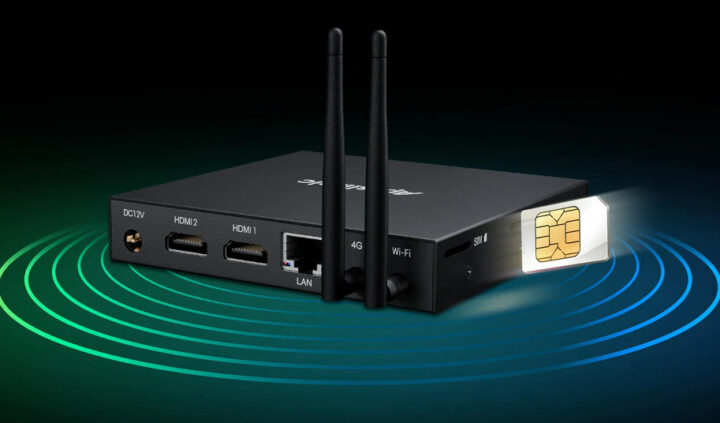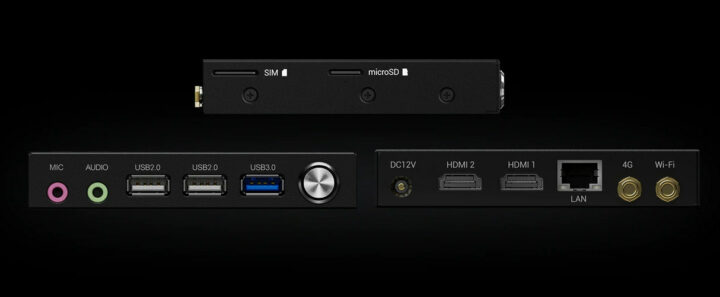Apcsilmic Dot 1 is an affordable Snapdragon 7c powered Windows 11 Arm Mini PC that offers an alternative to ECS LIVA Mini Box QC710 Desktop Snapdragon 7c developer kit with extra features and resources.
The Dot 1 mini PC comes with up to 8GB RAM, up to 256GB storage, dual HDMI output, as well as optional 4G LTE connectivity. It’s also thinner and remains fanless.
Apcsilmic Dot 1 Mini PC specifications:
- SoC – Qualcomm Snapdragon SC7180 (Snapdragon 7c) with octa-core Qualcomm Kryo 468 (2x Cortex-A76, 6x Cortex-A55) CPU @ up to 2.4 GHz, Adreno 618 GPU
- Memory & Storage options
- 4GB RAM + 64GB storage
- 6GB RAM + 128GB storage
- 8GB RAM + 256GB storage
- MicroSD card on all variants
- Video Output – 2x HDMI ports up to 2K resolution (2560×1440)
- Audio – 3.5mm MIC jack, 3.5mm stereo audio jack
- Networking
- 10/100M Ethernet
- Dual-band WiFi 5, Bluetooth 5.1 with SMA antenna
- Optional 4G LTE with SIM card slot and SMA antenna
- USB – 1x USB 3.0 port, 2x USB 2.0 ports
- Power Supply – 12V via DC jack
- Dimensions – TBD
The mini PC ships with a 12V power adapter, an HDMI cable, WiFi and 4G antennas (for 4G supported models), a user manual, and a monitor mount. It’s preloaded with Windows 11 for Arm, but without a license as per the FAQ:
Yes, it comes with a pre-installed Windows 11 but the Windows OS will be unlicensed. Users need to purchase a Windows license from Apcsilmic or Microsoft in order to activate Windows OS.
Such a license may cost $100 purchased directly from Microsoft but is available for a much cheaper price ($15) from OEM resellers. The latter may have limitations (e.g. can’t be transferred to another machine), but it does not look like Microsoft has any problem with those companies that have operated for years, often based in Hong Kong, and Microsoft lawyers did not even bother to issue DMCA takedowns.
Linux might be possible, but it’s complicated, and one person who’s tried booting Ubuntu Arm64 image on Acer Aspire 1 laptop got into a boot loop. The similar Snapdragon 7c Gen 2 SoC is designed for Chromebooks, so Chromium OS might be another option for the ones who like a challenge.
The same FAQ explains it is fanless because “it works on fewer resistors”, so there must have been a mistranslation here… The video below shows the mini PC should be based on a system-on-module (SoM) + carrier board design, but I’m unable to find any Snapdragon 7c/SC7180 SoM on the web.
Seeing Snapdragon 7c is a Cortex-A76/A55 processor reminds me of Rockchip RK3588 which should have similar single-core performance and better multiple core performance with four Cortex-A76 and five Cortex-A55, plus support for 4K video playback and output. Rockchip RK3588 will run Android 12 and some Linux distributions, while Snapdragon 7c should really only properly support Windows 11.
Apcsilmic Dot 1 Windows 11 Arm mini PC is quite affordable with pricing starting at $229 with 4GB RAM, 32GB flash, and no 4G LTE, going up to $309 for the model with 8GB RAM, 128GB eMMC flash, and 4G LTE connectivity. More details and purchase links can be found on the product page.
Via Liliputing and Windows Central

Jean-Luc started CNX Software in 2010 as a part-time endeavor, before quitting his job as a software engineering manager, and starting to write daily news, and reviews full time later in 2011.
Support CNX Software! Donate via cryptocurrencies, become a Patron on Patreon, or purchase goods on Amazon or Aliexpress








The physical design looks very nice, but they could have used a smaller power button to leave room for an extra USB3 port (or at least turned one of the other USB2 ports to USB3). Or they could have placed the ports vertically to increase their density. Also, too bad they choosed to use 30-year old 10/100 ethernet at an era where it will be the smallest port hence the limiting factor between any visited website and the browser. WiFi is not always an alternative especially when the devices density is high and there’s continuous streams (e.g. video surveillance). But I can easily imagine such devices being used in call centers and such environments that require many cheap devices making no noise nor heat with still decent performance.
But surely cheap call centres run on RPI400 windows/Linux.
> that require many cheap devices making no noise nor heat with still decent performance.
And why wouldn’t Jasper Lake CPUs fulfill that need already?
It’s barely on par with the old gemini lake CPUs, not even taking into account better x86 support.
If you’re head of IT in a call center the last thing you want(ed) to deal with is/was a huge fleet of crappy Windows boxes, be it Snapdragon (this thing here disqualifying itself due to laughable display resolution) or x86.
They used terminal servers back then combined with cheap ICA/RDP clients but today since everything runs inside a browser anyway this doesn’t matter. The call center slav^Wagents sit at home in a reverse ‘Bring Your Own Device’ situation.
It may only run windows but it has official support from MS unlike other SBC’s with android/linux which are vendor supplied builds that are abandoned after shipping.
Thats a big difference in terms of support.
Also the hardware should be fully supported in terms of video decode and encode.
Good to see a Snapdragon in a box, which might inspire others to come in and use them.
There are a couple of things that make you go oh no, like the 10/100 ethernet but early days.
With Android running on many a phone with a Snapdragon, then perhaps there may be scope for a custom firmware and of course Chrome OS.
Definitely a missed opportunity. I would have rather had one HDMI port supporting 4K60 and two 2.5 GbE ports, or at least two 1 GbE ports.
Welcome to the world of ARM SoCs. This box has been built around a SoC that originates from Qualcomm’s phone division -> crappy HDMI resolution and minimal I/O guaranteed.
This is not Qualcomm’s networking division and as such this SoC has no networking capabilities at all. The 10/100 Ethernet is most probably something like an RTL8152 behind an USB2 hub.
I call BS: ‘no networking capabilities’ should read of course ‘no wired networking capabilities’.
Yes, hence “no networking capabilites” 🙂